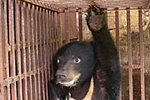
Managed grasslands with rainforest behind it in Khao Yai National Park. Photo by: Rhett A. Butler.
A four-year camera trap project has revealed that Khao Yai National Park in Thailand is still home to a wide-variety of carnivore species, but tigers may be on their way out or already gone finds a new study from mongabay.com’s open access journal Tropical Conservation Science. Photographing with 15 cameras the study snapped photos of 14 carnivore species in the park. However, the photographic evidence implies that predator populations have fallen in the park over the past decade due to human activities, including poaching.
“The number of photos per carnivore species ranged from one for marbled cat (Pardofelis marmorata to 37 for large Indian civet (Viverra zibetha). Asiatic black bear (Ursus thibetanus) was the second-most common carnivore species photographed,” the authors write. A number of carnivores caught on film are considered globally threatened: Asiatic golden cat (Pardofelis temminckii and the large Indian civet (Viverra zibetha) are listed as Near Threatened by the IUCN Red List; clouded leopard (Neofelis nebulosa), large spotted civet (Viverra megaspila), binturong (Arctictis binturong), Malayan sun bear (Helarctos malayanus) are all listed as Vulnerable; and the dhole (Cuon alpinus) is considered Endangered.
However, over 6,000 nights of surveying, no photos of tigers turned up.
“That tigers were not recorded by camera-trapping adds evidence to the notion that the species has disappeared from the park other than perhaps transient individuals,” the authors write.
The last evidence of a tiger in Khao Yai National Park was a footprint in 2005. Yet, camera traps did catch evidence of less-welcome visitors to park.
“Camera traps also recorded human traffic (poachers, rangers, villagers, tourists) and domestic dogs inside the park .The majority of poacher photographs were taken on the eastern boundary of the park; however, domestic dogs (most likely accompanied by people) intruded well into the interior of the park,” according to the paper. Domestic dogs may kill wildlife in the park or even worse spread disease.
In all the camera trap photos tell a disturbing tale of probable recent declines in wildlife in the park.
“We found significantly lower relative abundance indices for certain mammal species, and collectively for all mammals compared to data obtained in 1999-2000 from 34 similar survey locations,” the authors write.
More wildlife was photographed in higher elevations suggesting that poaching is largely behind the decline, as poachers are less willing to venture into high places.
The researchers recommend a large-scale camera trap monitoring program for the park to keep better tabs on wildlife populations.
“Despite continued threats and a decrease or near extirpation of tigers, Khao Yai National Park supports a diversity of carnivore species of conservation concern, including clouded leopards, dholes, and small felids. Dedicated efforts to monitor wildlife using simple tools such as camera traps will be essential to Khao Yai National Park’s future mission as part of a World Heritage Area,” the authors conclude.
CITATION: Jenks, K. E., Chanteap, P., Damrongchainarong, K., Cutter, P., Cutter, P., Redford, T., Lynam, A. J., Howard, J., and Leimgruber, P. Diversity of carnivore species despite a non-viable tiger population in Thailand’s Khao Yai National Park. Tropical Conservation Science Vol.4 (2):113-131, 2011.
Related articles
Environment versus economy: local communities find economic benefits from living next to conservation areas

(06/12/2011) While few would question that conserving a certain percentage of land or water is good for society overall, it has long been believed that protected areas economically impoverish, rather than enrich, communities living adjacent to them. Many communities worldwide have protested against the establishment of conservation areas near them, fearing that less access and increased regulations would imperil their livelihoods. However, a surprising study overturns the common wisdom: showing that, at least in Thailand and Costa Rica, protected areas actually boost local economies and decrease poverty.
Bear bile trade, both legal and illegal, ubiquitous in Asia
 (05/16/2011) Surveying 13 nations and territories in Asia, the wildlife trade organization TRAFFIC found that the bear bile trade remains practically ubiquitous in the region. In many cases the trade, which extracts bile from captive bears’ gall bladders for sale as a pharmaceutical, flouts both local and international law, including Appendix I of Convention on International Trade in Endangered Species of Wild Fauna and Flora (CITES ).
(05/16/2011) Surveying 13 nations and territories in Asia, the wildlife trade organization TRAFFIC found that the bear bile trade remains practically ubiquitous in the region. In many cases the trade, which extracts bile from captive bears’ gall bladders for sale as a pharmaceutical, flouts both local and international law, including Appendix I of Convention on International Trade in Endangered Species of Wild Fauna and Flora (CITES ).
From Cambodia to California: the world’s top 10 most threatened forests
 (02/02/2011) Growing populations, expanding agriculture, commodities such as palm oil and paper, logging, urban sprawl, mining, and other human impacts have pushed many of the world’s great forests to the brink. Yet scientists, environmentalists, and even some policymakers increasingly warn that forests are worth more standing than felled. They argue that by safeguarding vulnerable biodiversity, sequestering carbon, controlling erosion, and providing fresh water, forests provide services to humanity, not to mention the unquantifiable importance of having wild places in an increasingly human-modified world. Still, the decline of the world’s forests continues: the FAO estimating that around 10 million hectares of tropical forest are lost every year. Of course, some of these forests are more imperiled than others, and a new analysis by Conservation International (CI) has catalogued the world’s 10 most threatened forests.
(02/02/2011) Growing populations, expanding agriculture, commodities such as palm oil and paper, logging, urban sprawl, mining, and other human impacts have pushed many of the world’s great forests to the brink. Yet scientists, environmentalists, and even some policymakers increasingly warn that forests are worth more standing than felled. They argue that by safeguarding vulnerable biodiversity, sequestering carbon, controlling erosion, and providing fresh water, forests provide services to humanity, not to mention the unquantifiable importance of having wild places in an increasingly human-modified world. Still, the decline of the world’s forests continues: the FAO estimating that around 10 million hectares of tropical forest are lost every year. Of course, some of these forests are more imperiled than others, and a new analysis by Conservation International (CI) has catalogued the world’s 10 most threatened forests.